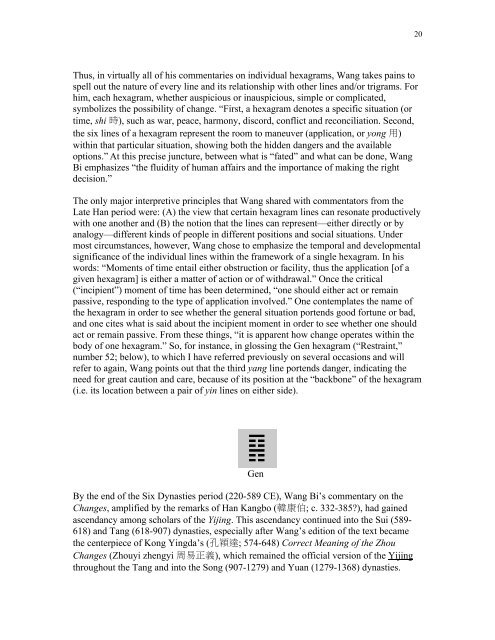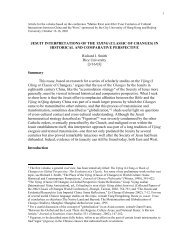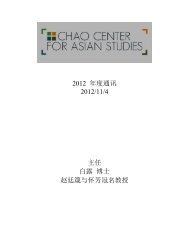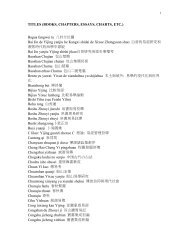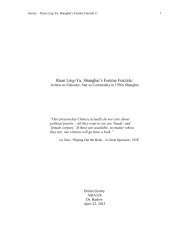20Thus, <strong>in</strong> virtually all <strong>of</strong> his commentaries on <strong>in</strong>dividual hexagrams, Wang takes pa<strong>in</strong>s tospell out <strong>the</strong> nature <strong>of</strong> every l<strong>in</strong>e <strong>and</strong> its relationship with o<strong>the</strong>r l<strong>in</strong>es <strong>and</strong>/or trigrams. Forhim, each hexagram, whe<strong>the</strong>r auspicious or <strong>in</strong>auspicious, simple or complicated,symbolizes <strong>the</strong> possibility <strong>of</strong> change. “First, a hexagram denotes a specific situation (ortime, shi ), such as war, peace, harmony, discord, conflict <strong>and</strong> reconciliation. Second,<strong>the</strong> six l<strong>in</strong>es <strong>of</strong> a hexagram represent <strong>the</strong> room to maneuver (application, or yong )with<strong>in</strong> that particular situation, show<strong>in</strong>g both <strong>the</strong> hidden dangers <strong>and</strong> <strong>the</strong> availableoptions.” At this precise juncture, between what is “fated” <strong>and</strong> what can be done, WangBi emphasizes “<strong>the</strong> fluidity <strong>of</strong> human affairs <strong>and</strong> <strong>the</strong> importance <strong>of</strong> mak<strong>in</strong>g <strong>the</strong> rightdecision.”The only major <strong>in</strong>terpretive pr<strong>in</strong>ciples that Wang shared with commentators from <strong>the</strong>Late Han period were: (A) <strong>the</strong> view that certa<strong>in</strong> hexagram l<strong>in</strong>es can resonate productivelywith one ano<strong>the</strong>r <strong>and</strong> (B) <strong>the</strong> notion that <strong>the</strong> l<strong>in</strong>es can represent—ei<strong>the</strong>r directly or byanalogy—different k<strong>in</strong>ds <strong>of</strong> people <strong>in</strong> different positions <strong>and</strong> social situations. Undermost circumstances, however, Wang chose to emphasize <strong>the</strong> temporal <strong>and</strong> developmentalsignificance <strong>of</strong> <strong>the</strong> <strong>in</strong>dividual l<strong>in</strong>es with<strong>in</strong> <strong>the</strong> framework <strong>of</strong> a s<strong>in</strong>gle hexagram. In hiswords: “Moments <strong>of</strong> time entail ei<strong>the</strong>r obstruction or facility, thus <strong>the</strong> application [<strong>of</strong> agiven hexagram] is ei<strong>the</strong>r a matter <strong>of</strong> action or <strong>of</strong> withdrawal.” Once <strong>the</strong> critical(“<strong>in</strong>cipient”) moment <strong>of</strong> time has been determ<strong>in</strong>ed, “one should ei<strong>the</strong>r act or rema<strong>in</strong>passive, respond<strong>in</strong>g to <strong>the</strong> type <strong>of</strong> application <strong>in</strong>volved.” One contemplates <strong>the</strong> name <strong>of</strong><strong>the</strong> hexagram <strong>in</strong> order to see whe<strong>the</strong>r <strong>the</strong> general situation portends good <strong>for</strong>tune or bad,<strong>and</strong> one cites what is said about <strong>the</strong> <strong>in</strong>cipient moment <strong>in</strong> order to see whe<strong>the</strong>r one shouldact or rema<strong>in</strong> passive. From <strong>the</strong>se th<strong>in</strong>gs, “it is apparent how change operates with<strong>in</strong> <strong>the</strong>body <strong>of</strong> one hexagram.” So, <strong>for</strong> <strong>in</strong>stance, <strong>in</strong> gloss<strong>in</strong>g <strong>the</strong> Gen hexagram (“Restra<strong>in</strong>t,”number 52; below), to which I have referred previously on several occasions <strong>and</strong> willrefer to aga<strong>in</strong>, Wang po<strong>in</strong>ts out that <strong>the</strong> third yang l<strong>in</strong>e portends danger, <strong>in</strong>dicat<strong>in</strong>g <strong>the</strong>need <strong>for</strong> great caution <strong>and</strong> care, because <strong>of</strong> its position at <strong>the</strong> “backbone” <strong>of</strong> <strong>the</strong> hexagram(i.e. its location between a pair <strong>of</strong> y<strong>in</strong> l<strong>in</strong>es on ei<strong>the</strong>r side).By <strong>the</strong> end <strong>of</strong> <strong>the</strong> Six Dynasties period (220-589 CE), Wang Bi’s commentary on <strong>the</strong>Changes, amplified by <strong>the</strong> remarks <strong>of</strong> Han Kangbo (; c. 332-385?), had ga<strong>in</strong>edascendancy among scholars <strong>of</strong> <strong>the</strong> Yij<strong>in</strong>g. This ascendancy cont<strong>in</strong>ued <strong>in</strong>to <strong>the</strong> Sui (589-618) <strong>and</strong> Tang (618-907) dynasties, especially after Wang’s edition <strong>of</strong> <strong>the</strong> text became<strong>the</strong> centerpiece <strong>of</strong> Kong Y<strong>in</strong>gda’s (; 574-648) Correct Mean<strong>in</strong>g <strong>of</strong> <strong>the</strong> ZhouChanges (Zhouyi zhengyi ), which rema<strong>in</strong>ed <strong>the</strong> <strong>of</strong>ficial version <strong>of</strong> <strong>the</strong> Yij<strong>in</strong>gthroughout <strong>the</strong> Tang <strong>and</strong> <strong>in</strong>to <strong>the</strong> Song (907-1279) <strong>and</strong> Yuan (1279-1368) dynasties.Gen
21Han-style New Text scholarship <strong>and</strong> Images <strong>and</strong> Numbers <strong>in</strong>terpretations did notdisappear entirely, however. In fact, <strong>in</strong> some circles <strong>the</strong>re was a resurgence <strong>of</strong> Han-stylecorrelative th<strong>in</strong>k<strong>in</strong>g. Dur<strong>in</strong>g <strong>the</strong> Tang period, <strong>for</strong> example, <strong>the</strong> five agents were firstmatched systematically with <strong>the</strong> eight trigrams. In <strong>the</strong> most common configuration, <strong>the</strong>Qian <strong>and</strong> Dui trigrams shared <strong>the</strong> agent metal; Sun <strong>and</strong> Zhen shared wood, <strong>and</strong> Gen <strong>and</strong>Kun shared earth. Kan was l<strong>in</strong>ked solely with water <strong>and</strong> Li was associated only with fire.In ano<strong>the</strong>r, less common, model, Qian <strong>and</strong> Kun shared both wood <strong>and</strong> water, Gen <strong>and</strong>Dui shared fire, Kan <strong>and</strong> Li shared earth, <strong>and</strong> Zhen <strong>and</strong> Sun shared metal. In ei<strong>the</strong>r case,<strong>the</strong> basic goal was to assure that <strong>in</strong> any given situation <strong>the</strong> conjunction <strong>of</strong> symbolicelements—whe<strong>the</strong>r trigrams, agents, or numbers—would be harmonious <strong>and</strong> <strong>the</strong>re<strong>for</strong>eauspicious. But to critics <strong>of</strong> this sort <strong>of</strong> cosmological th<strong>in</strong>k<strong>in</strong>g, like <strong>the</strong> Tang scholar L¸Cai (600-664) <strong>and</strong> his successors, ef<strong>for</strong>ts to correlate <strong>in</strong>commensurate numbersrepresented noth<strong>in</strong>g more than a “<strong>for</strong>ced fit” (qiangpei )It was dur<strong>in</strong>g <strong>the</strong> Tang dynasty that Buddhist <strong>and</strong> Daoist ideas, which had already begunto <strong>in</strong>fluence Yij<strong>in</strong>g scholarship <strong>in</strong> <strong>the</strong> Six Dynasties period, ga<strong>in</strong>ed ever greater visibility.Proponents <strong>of</strong> Daoist “alchemy,” <strong>for</strong> <strong>in</strong>stance, <strong>in</strong> <strong>the</strong>ir quest <strong>for</strong> longevity <strong>and</strong> eventualimmortality, <strong>in</strong>creas<strong>in</strong>gly saw <strong>the</strong> Changes as a convenient device by which to align <strong>the</strong>body <strong>and</strong> m<strong>in</strong>d with <strong>the</strong> cosmos. Likewise, Tang Buddhists, build<strong>in</strong>g on Six Dynastyprecedents, engaged <strong>the</strong> Yij<strong>in</strong>g to an unprecedented extent. This was particularly trueparticularly <strong>the</strong> variety <strong>of</strong> Buddhism known as Flowery Splendor (Huayan ). Fromthis po<strong>in</strong>t onward, as we shall see, Buddhist term<strong>in</strong>ology, imagery <strong>and</strong> symbolism<strong>in</strong>creas<strong>in</strong>gly found its way <strong>in</strong>to Changes exegesis.A Brief Account <strong>of</strong> Interpretations <strong>of</strong> <strong>the</strong> Changes <strong>in</strong> Late Imperial <strong>and</strong> Post-Imperial Times (960 CE-Present)The <strong>in</strong>tellectual <strong>and</strong> <strong>in</strong>stitutional challenge posed by Buddhism <strong>in</strong> <strong>the</strong> Tang dynastyresulted <strong>in</strong> <strong>the</strong> rise <strong>of</strong> “Neo-Confucianism” dur<strong>in</strong>g <strong>the</strong> Song dynasty. This new br<strong>and</strong> <strong>of</strong>metaphysically oriented Confucianism drew heavily on <strong>the</strong> Yij<strong>in</strong>g as a domestic source <strong>of</strong><strong>in</strong>spiration, a counterweight to <strong>the</strong> “alien” ideas <strong>of</strong> Buddhism. Neo-Confucianism tooktwo major <strong>for</strong>ms <strong>in</strong> <strong>the</strong> Song period <strong>and</strong> <strong>the</strong>reafter. One was <strong>the</strong> so-called School <strong>of</strong>Pr<strong>in</strong>ciple, which focused on <strong>the</strong> idea that <strong>in</strong> order to cultivate <strong>the</strong> “pr<strong>in</strong>ciple” <strong>of</strong> one’s<strong>in</strong>nate goodness, it was necessary to study <strong>the</strong> Confucian Classics assiduously, thusref<strong>in</strong><strong>in</strong>g one’s qi from without, so to speak. The o<strong>the</strong>r was <strong>the</strong> so-called School <strong>of</strong> <strong>the</strong>M<strong>in</strong>d, which emphasized <strong>the</strong> value <strong>of</strong> seek<strong>in</strong>g <strong>the</strong> pr<strong>in</strong>ciple <strong>of</strong> <strong>the</strong> <strong>in</strong>nately good selfwith<strong>in</strong>, primarily through meditation. Both schools placed a heavy emphasis on <strong>the</strong> power<strong>of</strong> <strong>the</strong> m<strong>in</strong>d, however. Thus, <strong>for</strong> all his <strong>in</strong>sistence on <strong>the</strong> importance <strong>of</strong> book-learn<strong>in</strong>g, one<strong>of</strong> <strong>the</strong> lead<strong>in</strong>g exponents <strong>of</strong> <strong>the</strong> School <strong>of</strong> Pr<strong>in</strong>ciple, Cheng Yi (; 1033-1107), couldwrite that “With <strong>the</strong> most highly developed s<strong>in</strong>cerity, [<strong>the</strong> m<strong>in</strong>d] can penetrate metal <strong>and</strong>stone, <strong>and</strong> overcome water <strong>and</strong> fire, so what dangers <strong>and</strong> difficulties can possibly keep itfrom prevail<strong>in</strong>g?”One <strong>of</strong> <strong>the</strong> many noteworthy features <strong>of</strong> early Song scholarship on <strong>the</strong> Yij<strong>in</strong>g is <strong>the</strong>pr<strong>of</strong>usion <strong>of</strong> charts <strong>and</strong> diagrams that suddenly appeared at that time, many <strong>of</strong> which


